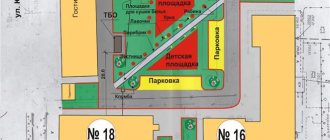- December 5, 2019
- Automobile law
- Yulia Lobach
In this article we will look at parking lot markings.
For safe road traffic and economical use of parking areas and parking lots, correct and competent markings in the parking lot are necessary.
Today, any trip for every car enthusiast turns into an adventure in finding a free parking space. The situation with parking is most difficult in the historical centers of large cities and in the courtyards of old buildings, where the urban plan does not provide space for the number of cars that there are today.
The dimensions of parking lot markings are regulated by GOST (51256-2011). If a citizen knows such information, it will be easier for him to defend his own rights if, for example, a car was hit and dented in a parking lot due to a narrow passage.
The concept of parking - what is it?
A park is usually understood as a designated area that must have a fence, an appropriate road sign and markings. Car spaces are provided free of charge, for example, in parking lots located near public places, or for a fee if the parking is municipal or private. Municipal parking lots usually use the Parkon automated parking system.
To assign an area the official status of a parking lot, it must be registered and formalized in accordance with all legal requirements. Currently, the parameters of parking areas are regulated by SNiP 113.133330.2016 with the title “Car Parking”.
We will explain below what types of parking markings there are.
Locations of parking areas
The location of the parking area and markings depends on many factors:
- Size (number of parking spaces).
- Distance from public places and environmental sites.
Any parking lot must be safe, and the list of potential threats from parking areas, even if they are located outdoors, is quite extensive: exhaust fumes, gasoline leaks, road accidents, fires.
If we think from the other side - from the point of view of the car owner, then the most convenient parking is the one that is located closest to the required place. Usually, no one wants to walk an extra distance to a hospital, shopping mall, office or any other public place.
The distance at which parking markings should be located from urban planning objects is regulated by SNiP “Car Parking”.
If a car park can accommodate 10 or fewer cars, it must be located 10 meters from public buildings and residential buildings. Such car parking should be at least 25 meters away from public gardens, city parks, playgrounds and sports grounds, hospitals, schools and kindergartens.
Parking lots accommodating 10-50 cars should be located at a distance of 15 meters from residential buildings whose walls have windows, and at a distance of 30 meters from hospitals, schools, kindergartens and other similar buildings.
Open parking areas accommodating up to 100 cars must be 25 meters away from residential buildings. They should be located at the same distance from various public institutions.
Large car parks with up to 300 parking spaces should be located:
- at a distance of 35 meters from residential buildings with windows;
- 50 meters - from kindergartens, vocational schools, schools, and other children's institutions;
- 60 meters from recreational areas for citizens, sports grounds and stadiums, and medical institutions.
Car parks with a capacity of over 300 cars must be 50 meters away from residential buildings with windows. Other requirements for such parking areas do not change. As for huge parking lots that can accommodate 500 cars or more, they are recommended to be located exclusively in industrial zones.
SanPiN 2.1.4.1074 prohibits the placement of open parking areas in areas where water intake for domestic and drinking purposes occurs.
Requirements for parking to ensure parking of vehicles
Hello colleagues.
On January 1, 2020, Order of the Ministry of Transport of the Russian Federation dated May 17, 2020 No. 199 “On approval of the Requirements for parking lots (parking spaces) to ensure parking of vehicles owned by legal entities and individual entrepreneurs transporting passengers on the basis of a contract of carriage” comes into force or a contract of freight and (or) cargo on the basis of a contract of carriage (commercial transportation), as well as those carrying out the movement of persons, except the driver, located in a vehicle (on it), and (or) material objects without concluding the specified contracts (transportation for one’s own needs ), within the boundaries of urban settlements, urban districts, federal cities of Moscow, St. Petersburg and Sevastopol upon returning from a trip and the end of the driver’s shift.”
This Order approved the Requirements for parking lots (parking spaces) to ensure parking of vehicles within the boundaries of urban settlements, districts, and federal cities upon return from a trip and the end of a driver’s shift.
We are talking about vehicles owned by legal entities and individual entrepreneurs carrying out commercial transportation (transportation of passengers on the basis of a contract of carriage or a charter agreement and (or) cargo on the basis of a contract of carriage), as well as transportation for their own needs (movement of persons other than the driver, located in the vehicle (on it), and (or) material objects without concluding the specified agreements).
The organization of entrances to and exits from parking lots, as well as the movement of vehicles in parking lots, must be carried out in accordance with traffic management projects. Parking is located on a site that has a permanent, lightweight or transitional type of road pavement. It is not allowed to create parking lots in public areas within the boundaries of an element of the planning structure built up with apartment buildings.
From January 1, 2020, Order of the Ministry of Transport of the Russian Federation dated April 19, 2020 No. 108 “On approval of Parking Requirements for parking at night of vehicles used for regular transportation of passengers and luggage by road transport and urban ground electric transport, in the absence driver” was declared invalid.
I suggest you familiarize yourself with the new document.
Order of the Ministry of Transport of the Russian Federation dated May 17, 2020 No. 199 “On approval of the Requirements for parking lots (parking spaces) to ensure parking of vehicles owned by legal entities and individual entrepreneurs transporting passengers on the basis of a contract of carriage or a contract of freight and (or) cargo on the basis of a contract of carriage (commercial transportation), as well as those carrying out the movement of persons, except the driver, located in the vehicle (on it), and (or) material objects without concluding the specified contracts (transportation for one’s own needs), within the boundaries of urban settlements, urban districts, federal cities of Moscow, St. Petersburg and Sevastopol upon returning from a flight and the end of the driver’s shift"
August 6, 2018
In accordance with Part 2 of Article 20 of the Federal Law of December 10, 1995 No. 196-FZ “On Road Safety” (Collected Legislation of the Russian Federation, 1995, No. 50, Art. 4873; 1999, No. 10, Art. 1158; 2002 , No. 18, Art. 1721; 2003, No. 2, Art. 167; 2004, No. 35, Art. 3607; 2006, No. 52, Art. 5498; 2007, No. 46, Art. 5553, No. 49, Art. 6070 ; 2009, No. 1, Article 21, No. 48, Article 5717; 2010, No. 30, Article 4000, No. 31, Article 4196; 2011, No. 17, Article 2310, No. 27, Article 3881, No. 29, Article 4283, No. 30, Article 4590, 4596; 2012, No. 25, Article 3268, No. 31, Article 4320; 2013, No. 17, Article 2032, No. 19, Article 2319, No. 27, Article 3477, No. 30, Article 4029, No. 48, Article 6165, No. 52, Article 7002; 2014, No. 42, Article 5615; 2015, No. 24, Article 3370, No. 29, Article 4359, No. 48, Art. 6706, 6723; 2020, No. 15, Art. 2066, No. 18, Art. 2502, No. 27, Art. 4192, 4229; 2020, No. 31, Art. 4753) I order:
1. Approve the attached Requirements for parking lots (parking spaces) to ensure parking of vehicles belonging to legal entities and individual entrepreneurs transporting passengers on the basis of a contract of carriage or a charter agreement and (or) cargo on the basis of a contract of carriage (commercial transportation), as well as carrying out the movement of persons, except for the driver, located in the vehicle (on it), and (or) material objects without concluding the specified contracts (transportation for their own needs), within the boundaries of urban settlements, urban districts, federal cities of Moscow, St. Petersburg and Sevastopol upon returning from a flight and the end of the driver’s shift.
2. Recognize as invalid the order of the Ministry of Transport of the Russian Federation dated April 19, 2020 No. 108 “On approval of Parking Requirements for parking at night of vehicles used for regular transportation of passengers and luggage by road transport and urban ground electric transport, in the absence driver" (registered by the Ministry of Justice of Russia on May 27, 2020, registration No. 42322).
3. Establish that this order comes into force on January 1, 2020.
Minister E.I. Dietrich
Registered with the Ministry of Justice of the Russian Federation on August 2, 2020 Registration No. 51763
APPROVED by order of the Ministry of Transport of Russia dated May 17, 2020 No. 199
Requirements for parking lots (parking spaces) to ensure parking of vehicles belonging to legal entities and individual entrepreneurs transporting passengers on the basis of a contract of carriage or a charter agreement and (or) cargo on the basis of a contract of carriage (commercial transportation), as well as transporting persons, except for the driver, located in the vehicle (on it), and (or) material objects without concluding the specified contracts (transportation for one’s own needs), within the boundaries of urban settlements, urban districts, federal cities of Moscow, St. Petersburg and Sevastopol upon return from flight and the end of the driver's shift
1. These Requirements for parking lots (parking spaces) to ensure parking of vehicles belonging to legal entities and individual entrepreneurs carrying out transportation of passengers on the basis of a contract of carriage or a contract of chartering and (or) cargo on the basis of a contract of carriage (commercial transportation), as well as carrying out movement of persons, except the driver, in a vehicle (on it), and (or) material objects without concluding the specified contracts (transportation for one’s own needs), within the boundaries of urban settlements, urban districts, federal cities of Moscow, St. Petersburg and Sevastopol upon returning from a trip and the end of the driver’s shift (hereinafter referred to as vehicles, parking lots, respectively) are developed in accordance with Part 2 of Article 20 of the Federal Law of December 10, 1995 No. 196-FZ “On Road Traffic Safety”.
2. The organization of vehicle entries into and exit from parking lots, as well as the movement of vehicles in parking lots, must be carried out in accordance with traffic management projects.
3. Parking must be:
illuminated in accordance with the requirements provided for in paragraphs 7.47 and 7.48 of SP 52.13330.2011 “SNiP 23-05-95 Natural and artificial lighting”, if they are located outside a building or structure in the dark;
marked and equipped with technical means of traffic management in accordance with traffic management projects;
arranged on a site that has a permanent, lightweight or transitional type of road pavement that meets the requirements provided for in paragraphs 8.1 - 8.5, 8.7 - 8.14, 8.16, 8.17, 8.19 - 8.38 SP 34.13330.2012 “SNiP 2.05.02-85 “Highways”1 , if they are located outside a building or structure, with the exception of parking for trams;
placed in accordance with the requirements specified in table 7.1.1 SanPiN 2.2.1/2.1.1.1200-03 “Sanitary protection zones and sanitary classification of enterprises, structures and other objects”, approved by the resolution of the Chief State Sanitary Doctor of the Russian Federation dated September 25, 2007 No. 74.
4. The creation of parking lots on public territory within the boundaries of an element of the planning structure built up with apartment buildings is not allowed.
See also: Identification marks installed on vehicles
Dimensions of parking spaces in open parking lots
The size of a parking space for 1 car in a parking lot is easy to calculate if you know that the following parameters are the minimum:
- The length of the parking space is 5.3 meters.
- The width of the parking lot is 2.5 meters
Moreover, the width of the marking, which is 10 cm on each side, is not taken into account. That is, a parking space must have a minimum area of 13.25 square meters.
It is important that the standard length of a car is considered to be 4.4 meters, width - 1.8 meters.
At the discretion of the owners of the parking area, the size of the parking space may be increased. For example, parallel parking will be most comfortable if the length of one parking space is 8.8 meters, that is, equal to the length of 2 standard cars. In this case, the comfortable size of a parking space is considered to be the width of a standard car plus 1 meter, that is, 2.8 meters. This width of the parking space allows you to ensure the safety of the driver or his passenger getting out of the car.
If we talk about herringbone parking, then more space is needed. According to the standard, one such parking space must have an area of 18 square meters.
Parking spaces intended for parking cars for disabled people reach their maximum dimensions. Their width reaches 3.6 meters, and their length is 6.2 meters.
The law allows deviations from the specified dimensions, but such a deviation must be within 5 cm. Such dimensions are primarily due to fire safety measures. In addition, they help reduce the likelihood of accidents in parking areas.
What are the standards for parking lot markings?
Dimensions of parking markings in the yard
Although in some countries the size of a parking space is strictly regulated by law, in Russia such markings are carried out at the discretion of local authorities. Because of this, the area intended for a car sometimes reaches the point of absurdity.
Here, for example, in the photo is one of the parking spaces for disabled people inside the courtyard of the local area:
For comparison, it is worth citing the requirements for the size of a parking space in Cyprus:
- the parking width for one car is at least 2.5 meters;
- length from 5 meters;
- the distance between ready rows of vehicles is at least 5 meters.
When creating an area for the disabled, an even larger margin is left for convenient loading and exiting in a wheelchair.
The dimensions of a parking space according to GOST in Russia should be as follows:
- width of dividing strip 10 cm;
- parking space width 2.3 m;
- The width of the passage between the rows is 6 m.
In practice, no one pays attention to the good example of progressive countries and vehicles are still advocated on sidewalks and lawns:
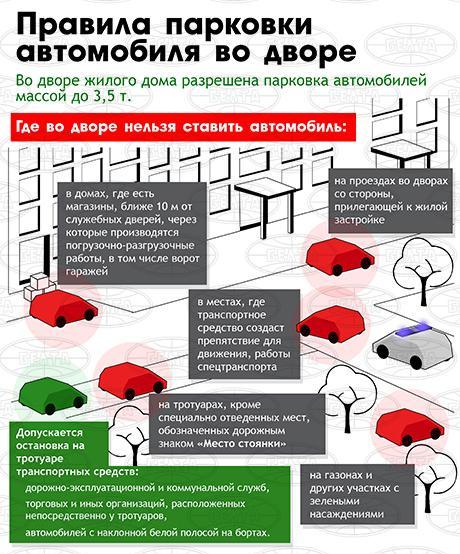
Where to get permission
Some home ownership administrations decide to organize decent parking spaces on their own that do not lead drivers into conflict situations.
Parking will be considered spontaneous or illegal in the following situations:
- if she violates traffic rules;
- if located contrary to sanitary standards.
You can stop this by filing a complaint with your local traffic police department.
If a building manager decides to organize parking near an apartment building, the following permitting actions may be required:
- make sure that the territory is really considered adjacent to a particular house;
- obtain information about land surveying (you must write an application to the Land Resources Committee for the formation of a land plot near an apartment building; on the basis of Part 3 of Article 16 of the Federal Law of December 29, 2004 No. 189-FZ “On the entry into force of the Housing Code of the Russian Federation”) ;
- register the land plot with cadastral registration.
After these steps, a general meeting of residents is held, a protocol is drawn up, signed by those who agree. There should be most of them.
The following issues are also decided by general voting:
- determining the project financing method;
- appointment of a person responsible for the process.
After this, you can move on to the next stage.
Drafting
The project is really necessary. As a rule, its development is entrusted to professionals and a contract is concluded for its preparation.
The finished project should include:
- a complete diagram of the parking zone;
- expected markings;

- vehicle traffic pattern;
- location of road signs;
- fire markings.
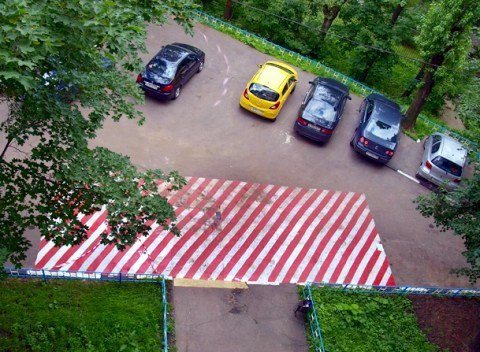
The finished project must comply with all traffic rules and sanitary standards. Particular attention should be paid to the size of parking spaces and the placement of signs.
Depending on the type and format of the parking lot, you can add the following location to the project:
- checkpoints;
- placement of barriers (blockers, concrete hemispheres, parking bollards);
- fences and barriers in the parking lot;
- lighting;
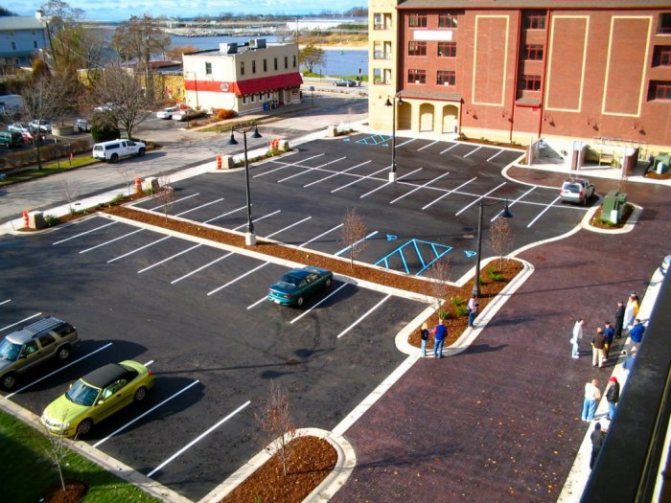
- CCTV camera location.

- If funds are available and there is a very large shortage of free space, mechanical parking devices are used.

When the development company completes the preparation of the project, it must be approved by the following local authorities:
- traffic police;
- Committee for Urban Planning and Architecture;
- district administration.
Only after each organization approves the prepared project can further actions begin. It is worth considering that obtaining approval from each of these structures may not be easy.
The article will tell you about the no parking sign: No parking sign. Perpendicular parking, read about it here.
The project must comply with fire safety standards. If a company offers assistance in completing these services and preparing the necessary documents, it is better to use these services than to try to achieve something on your own.
After the finished project has been approved by all these services, documents can be prepared for transfer to the regional committee for land resources and land management.
Specifics of registration for disabled people
It is important to take into account that regardless of whether disabled people currently live in an apartment building or not, there are legislative acts that protect the rights of this category of the population.
This is important to consider when organizing parking near a residential building:
- there is a law “On the social protection of persons with disabilities in the Russian Federation”, and Article 15 states that parking spaces for persons with disabilities must be organized near each socially significant place;
- At least 10% of the total parking spaces must be allocated; this means that in a parking lot of 10 spaces, at least one must be marked with a special “Disabled” sign, and appropriate markings must be applied to the concrete. For a parking lot with 50 spaces, this norm is 5 spaces;
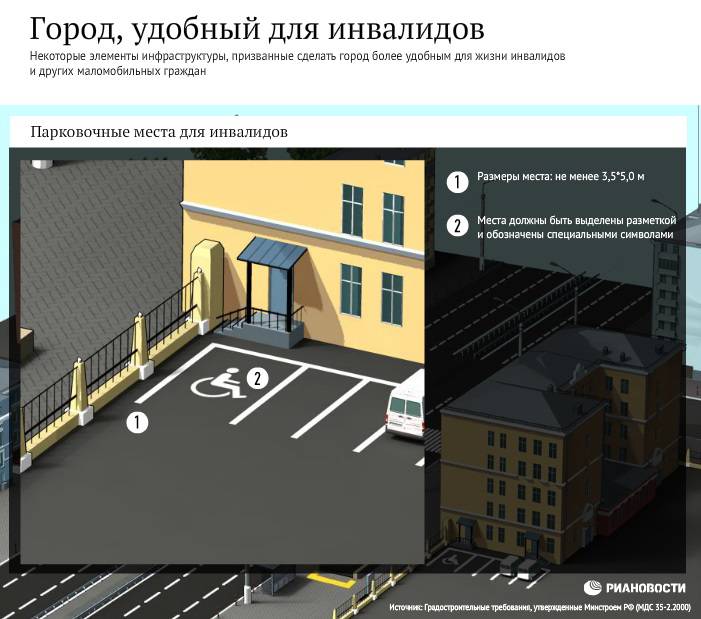
- The land owner is responsible for organizing such a zone; this means that when organizing local parking, the administration of a residential building must take this factor into account.
The absence of special areas for parking for disabled people or failure to install identification signs will result in an administrative penalty.
In accordance with the Code of Administrative Offenses (Article 5.43 of the Code of Administrative Offences), the following punishment may follow:
- for individuals – 3,000 – 5,000 rubles fine;
- for legal entities - 30,000 - 50,000 rubles fine.
The legislation very clearly identifies requirements that protect the interests of citizens with disabilities.
Therefore, they should not be neglected when creating a parking zone near an apartment building, even if no one with disabilities currently lives there.
What documents are required
The prepared project, approved by all services, must be submitted to the Department of Land Resources.
It is necessary to collect and attach the following package of documents:
- a certificate confirming ownership of a land plot adjacent to an apartment building;
- minutes of the meeting signed by residents (original only);
- certificate from the cadastral register about the area of the local area.
After submitting the documents, you can enter into an agreement with the contractor and create all the conditions for him to perform technical work. Some people decide to save money and want to do everything on their own. In practice this turns out to be ineffective.
Without the necessary equipment, knowledge and skills, it is impossible to carry out such a project efficiently. Therefore, it is better to entrust all the work to some trusted company with a good reputation.
Technical requirements for marking parking spaces
Technical requirements include not only the organization of the parking space as a whole, but the materials from which the fences are made and with which markings are applied:
- If parking is located in the local area, then it must have clearly defined boundaries. To create its boundaries, a side stone should be used.
- The pole or vertical support must have clear reflective markings. In particular, this paragraph applies to parking areas located in courtyards.
- To apply markings to asphalt pavement, thermoplastic or nitro paint should be used. But practice shows that white water-based paint is often used for this purpose, which is washed off by precipitation in less than a season.
Rules for organizing a parking space
It is important to know that only residents, or rather, apartment owners and their heirs, have the right to decide how and in what way to use the local area. To begin with, if this has not been done in advance, this land must be registered with the cadastral chamber. All actions on it are carried out in accordance with the Housing Code and this happens according to several rules:
- At a general meeting, the owners of the areas decide what they want to do with the existing space in front of the apartment building.
- For the results to be legal, the majority of residents must vote for one or another answer. Nothing can be done by a minority.
- All decisions must be recorded and signed.
- Only after this can you begin any actions and actual construction.
According to SanPin standards, any home parking must meet several requirements:
- The parking area in front of a residential building can accommodate no more than 50 cars.
- There should be more than 10 meters from the facade of the building to the parking areas, provided that the entire parking lot is designed for 15 spaces.
- If there will be a lot of vehicles, then the parking lot must be removed 15 m from the walls of the house.
It is also advisable to know that no car can be parked in the yard of a house with the engine running, unless passengers are disembarking from it.

Disabled parking space
Let’s talk about the “Parking for disabled people without sign” markings.
In the modern world, many car owners have limited capabilities, that is, they are disabled. There are especially many who use a wheelchair. Special standards have been developed for citizens of this category. To begin with, the size of the parking space has been increased to 3.6 * 6.2 meters. This is necessary so that a person in a wheelchair can move unhindered between the car rows. In addition, parking spaces for disabled people should be located as close as possible to the entrance of the building.
Car spaces intended for disabled people occupy approximately 20% of the entire parking area. Typically, spaces for the disabled can be found in parking lots near hospitals, shops, shopping centers, residential complexes and other public buildings.
Questions about organizing parking in the local area
Another question from a reader: “Hello! Our chairman installed signs in the parking lot near the house, supposedly there is a “day” and “night” parking lot, and prohibits residents from parking their cars at night in the daytime parking lot. He also claims that only residents have the right to park their cars in principle, and guests can park where they want. Please tell me, are residents required to pay money monthly to the HOA?”
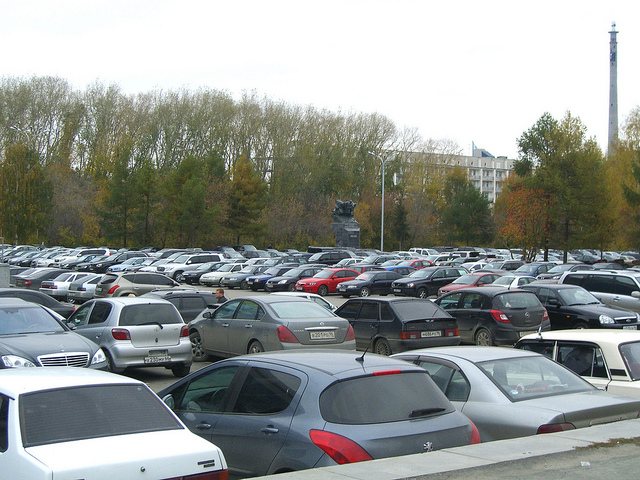
Previously, we considered the question of whether the HOA has the right to prohibit parking a car in the courtyard of the house. Let us remind you that the HOA, according to Article 137 of the Housing Code of the Russian Federation, cannot prohibit the owners of an apartment building from leaving their car in a parking space. In addition, the HOA is a non-profit organization that is created for the purpose of managing and representing the interests of home owners in utility organizations!
Moving on to a specific example, we note that the HOA representative cannot install signs and divide parking into “night” and “day” at his own discretion. Only the owners of an apartment building can dispose of a land plot (in particular, organize parking and impose restrictions on the use of parking spaces). Based on the results of the general meeting, which is held in the presence of both members of the HOA and other home owners, decisions and actions are taken on the organization of parking spaces.
A vote is held, based on the results of which a regulation on the procedure for entry and parking of vehicles on the adjacent land plot is signed. Only a decision of the general meeting (with the consent of more than 2/3 of the votes) can be considered binding for all owners of an apartment building (see Article 46 of the Housing Code of the Russian Federation). If in the minutes of the meeting or the final regulations on the organization of parking spaces in the local area there is a clause on the creation of “night” and “day” parking, then the actions of the HOA representative can be considered legal. Otherwise, no one can prohibit parking a car in the parking place where the owner of the house wishes.

Also, if the regulations on the procedure for entry and parking of vehicles provide for restrictions on the entry of guest cars, then representatives of the HOA have the full right to prohibit “strangers” from parking. However, owners who have assigned parking spaces can provide the guest with a chip (entry key) and allow them to leave the car in their place.
In turn, the right to park a car on the territory of an apartment building has every owner who has registered this right and pays a monthly fee for the maintenance and servicing of the parking lot without arrears. Otherwise, members of the HOA and those responsible for organizing parking have the right to prohibit leaving the car until all arrears on fees are paid off. These and other conditions must be reflected in an official document (for example, in the regulations on the entry and organization of parking spaces in the local area), agreed upon at a general meeting of residents.


